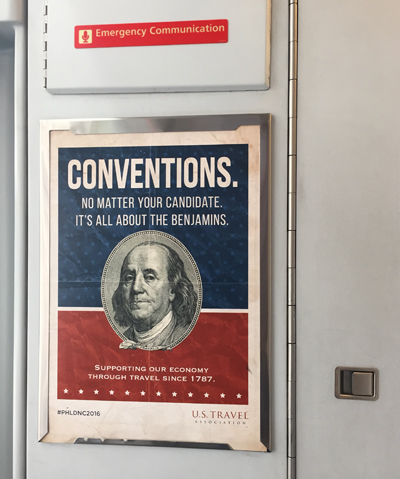DNC to Create $180 Million in Direct Spending for Philadelphia
July 26, 2016
U.S. Travel has placed ads extolling the economic value of the political conventions in Amtrak Acela trains in the Northeast corridor.
Between getting there, staying there, eating and drinking there, and all other activity, attendees of the Democratic National Convention (July 25–28) will be responsible for spending an estimated $180 million in Philadelphia, according to a projection from the U.S. Travel Association. Including indirect and induced impact, DNC attendees are expected to generate a total of $300 million in economic output. That total could support 1,800 additional jobs in Philadelphia.
“You’re going to hear a lot from the candidates about their plans to create jobs,” said U.S. Travel Association President and CEO Roger Dow. “It might give some people pause, but one of the easiest ways to do that is to hold more conventions. The economic activity associated with these kinds of events is extremely compelling, and we aim to make sure our policymakers understand that.”
Dow added: “These projections do not even take into account potential future visits to Philadelphia inspired by both convention-goers’ experience this week and images and stories from the event broadcast around the world. When a city puts its best foot forward during major gatherings like the DNC, business visitors are more likely to return for vacations, and the economic benefits are further multiplied for years to come.”
U.S. Travel’s forecast focuses on spending by attendees on items such as lodging, meals, transportation and general retail; as well as spending by the host committee, funding for security, etc.
Throughout its 75-year history, the U.S. Travel Association has conducted extensive economic research on domestic and international travel activity. This includes frequent economic impact studies of major travel-related events, such as meetings, conventions and holidays, as well as significant interruptions like severe weather events and government shutdowns.
U.S. Travel economists generated the convention impact figures using hotel data provided by the travel research firm STR, as well as other travel and economic statistics. The organization’s goal is to highlight the substantial and positive economic and jobs impact of large, in-person meetings such as political conventions.
The numbers for Philadelphia come as part of a larger-scale analysis of both the DNC and the Republican National Convention last week in Cleveland. The total impact of both conventions is split straight down the middle for each host city — $180 million in spending, $300 million in economic output and 1,800 jobs in both Philadelphia and Cleveland.
Some of the combined numbers for both conventions:
- Total projected attendees: 100,000–120,000
- Delegates: 10,000–12,000
- Media members: 30,000–36,000
- Other visitors and participants: 60,000–72,000
- Average daily trip spending per attendee: $300
- Hotel/other lodging room nights: 148,500
- Total lodging revenues: $33 million
U.S. Travel is amplifying its message that travel is “serious business” with an advertising campaign targeted at convention attendees. The organization has placed ads extolling the economic value of the political conventions in Amtrak Acela trains in the Northeast corridor, mirroring similar messaging installed in Cleveland Hopkins International Airport.
Additionally, U.S. Travel will have a branding presence at the Politico Hub in Philadelphia, an oasis featuring refreshments, speakers and entertainment. U.S. Travel-sponsored items at those venues will include several convention “necessities” including charging stations for electronic devices, pillows, chewable coffee and oxygen bars.
Said Dow: “Conventions and in-person meetings are an absolutely vital creator of accessible, good-paying, un-exportable jobs in this country. An effective way to remind our policymakers of that is to make sure the message is front and center while they’re all in one place.”
A more detailed version of the impact predictions by U.S. Travel researchers is available here.








